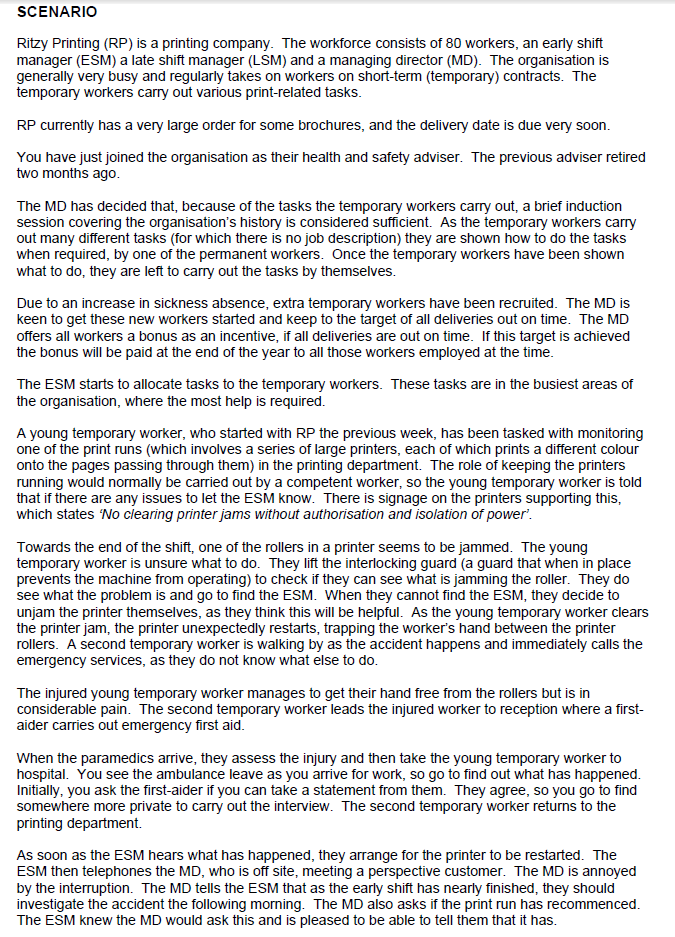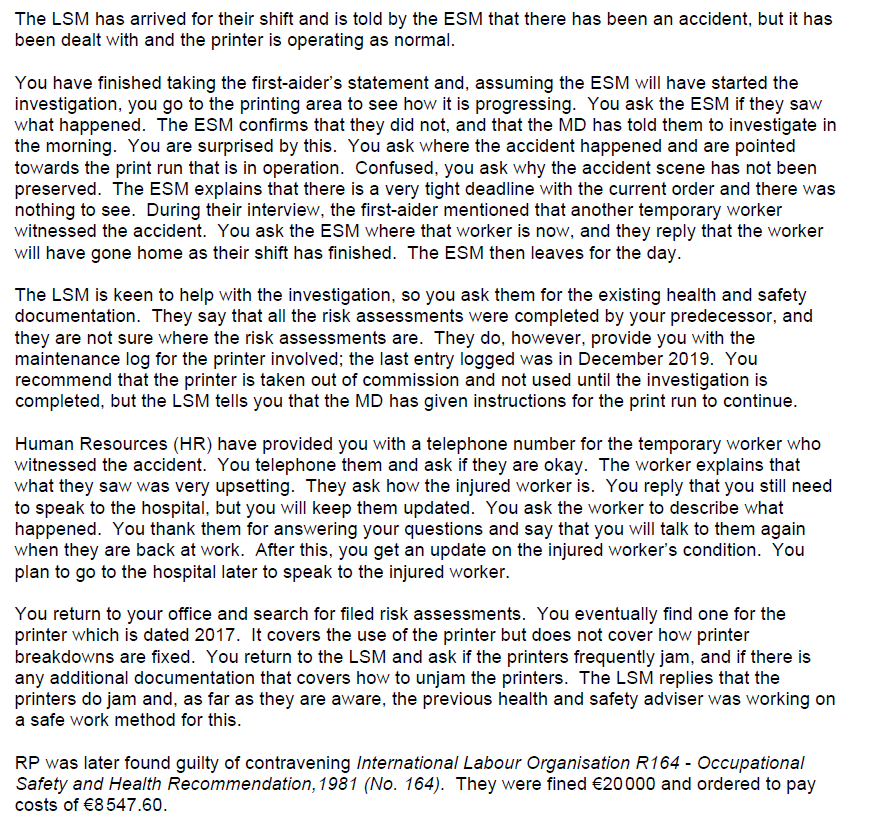

 (ACCURATE PLEASE)
(ACCURATE PLEASE)
Ritzy Printing (RP) is a printing company. The workforce consists of 80 workers, an early shift manager (ESM) a late shift manager (LSM) and a managing director (MD). The organisation is generally very busy and regularly takes on workers on short-term (temporary) contracts. The temporary workers carry out various print-related tasks. RP currently has a very large order for some brochures, and the delivery date is due very soon. You have just joined the organisation as their health and safety adviser. The previous adviser retired two months ago. The MD has decided that, because of the tasks the temporary workers carry out, a brief induction session covering the organisation's history is considered sufficient. As the temporary workers carry out many different tasks (for which there is no job description) they are shown how to do the tasks when required, by one of the permanent workers. Once the temporary workers have been shown what to do, they are left to carry out the tasks by themselves. Due to an increase in sickness absence, extra temporary workers have been recruited. The MD is keen to get these new workers started and keep to the target of all deliveries out on time. The MD offers all workers a bonus as an incentive, if all deliveries are out on time. If this target is achieved the bonus will be paid at the end of the year to all those workers employed at the time. The ESM starts to allocate tasks to the temporary workers. These tasks are in the busiest areas of the organisation, where the most help is required. A young temporary worker, who started with RP the previous week, has been tasked with monitoring one of the print runs (which involves a series of large printers, each of which prints a different colour onto the pages passing through them) in the printing department. The role of keeping the printers running would normally be carried out by a competent worker, so the young temporary worker is told that if there are any issues to let the ESM know. There is signage on the printers supporting this, which states 'No clearing printer jams without authorisation and isolation of power'. Towards the end of the shift, one of the rollers in a printer seems to be jammed. The young temporary worker is unsure what to do. They lift the interlocking guard (a guard that when in place prevents the machine from operating) to check if they can see what is jamming the roller. They do see what the problem is and go to find the ESM. When they cannot find the ESM, they decide to unjam the printer themselves, as they think this will be helpful. As the young temporary worker clears the printer jam, the printer unexpectedly restarts, trapping the worker's hand between the printer rollers. A second temporary worker is walking by as the accident happens and immediately calls the emergency services, as they do not know what else to do. The injured young temporary worker manages to get their hand free from the rollers but is in considerable pain. The second temporary worker leads the injured worker to reception where a firstaider carries out emergency first aid. When the paramedics arrive, they assess the injury and then take the young temporary worker to hospital. You see the ambulance leave as you arrive for work, so go to find out what has hapened. Initially, you ask the first-aider if you can take a statement from them. They agree, so you go to find somewhere more private to carry out the interview. The second temporary worker returns to the printing department. As soon as the ESM hears what has happened, they arrange for the printer to be restarted. The ESM then telephones the MD, who is off site, meeting a perspective customer. The MD is annoyed by the interruption. The MD tells the ESM that as the early shift has nearly finished, they should investigate the accident the following morning. The MD also asks if the print run has recommenced. The ESM knew the MD would ask this and is pleased to be able to tell them that it has. The LSM has arrived for their shift and is told by the ESM that there has been an accident, but it has been dealt with and the printer is operating as normal. You have finished taking the first-aider's statement and, assuming the ESM will have started the investigation, you go to the printing area to see how it is progressing. You ask the ESM if they saw what happened. The ESM confirms that they did not, and that the MD has told them to investigate in the morning. You are surprised by this. You ask where the accident happened and are pointed towards the print run that is in operation. Confused, you ask why the accident scene has not been preserved. The ESM explains that there is a very tight deadline with the current order and there was nothing to see. During their interview, the first-aider mentioned that another temporary worker witnessed the accident. You ask the ESM where that worker is now, and they reply that the worker will have gone home as their shift has finished. The ESM then leaves for the day. The LSM is keen to help with the investigation, so you ask them for the existing health and safety documentation. They say that all the risk assessments were completed by your predecessor, and they are not sure where the risk assessments are. They do, however, provide you with the maintenance log for the printer involved; the last entry logged was in December 2019. You recommend that the printer is taken out of commission and not used until the investigation is completed, but the LSM tells you that the MD has given instructions for the print run to continue. Human Resources (HR) have provided you with a telephone number for the temporary worker who witnessed the accident. You telephone them and ask if they are okay. The worker explains that what they saw was very upsetting. They ask how the injured worker is. You reply that you still need to speak to the hospital, but you will keep them updated. You ask the worker to describe what happened. You thank them for answering your questions and say that you will talk to them again when they are back at work. After this, you get an update on the injured worker's condition. You plan to go to the hospital later to speak to the injured worker. You return to your office and search for filed risk assessments. You eventually find one for the printer which is dated 2017. It covers the use of the printer but does not cover how printer breakdowns are fixed. You return to the LSM and ask if the printers frequently jam, and if there is any additional documentation that covers how to unjam the printers. The LSM replies that the printers do jam and, as far as they are aware, the previous health and safety adviser was working on a safe work method for this. RP was later found guilty of contravening International Labour Organisation R164 - Occupational Safety and Health Recommendation, 1981 (No. 164). They were fined 20000 and ordered to pay costs of 8547.60. Task 5: Risk assessment Based on the scenario only, comment on the organisation's approach to assessing health and safety risks. Note: You only need to focus on the general approach of the organisation to assessing health and safety risks, and NOT a detailed 5-step approach


 (ACCURATE PLEASE)
(ACCURATE PLEASE)





